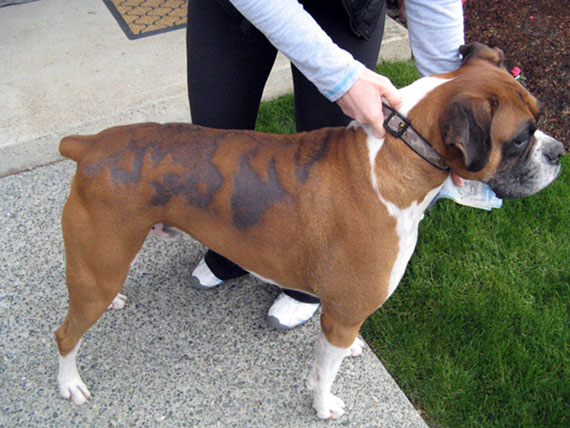Hair Loss Patches On Dogs
Hair Loss Patches On Dogs - If you're a dog owner, you already know that their furry coat is one of the most beautiful and distinctive features they possess. However, when your dog starts losing their hair, it can be a disconcerting and worrisome experience. Hair loss patches in dogs can be caused by a variety of factors, and it's essential to identify the cause so that you can take the appropriate steps to address the problem effectively.
What Causes Hair Loss in Dogs?
1. Parasites
Parasites such as fleas, ticks, and mites can cause intense itching, inflammation, and hair loss on your dog's skin. Fleas, in particular, are notorious for causing hair loss in dogs because they feed on your dog's blood, weakening them and causing skin allergies. Regular grooming and checking for parasites on your dog's body are crucial in preventing hair loss from these pesky critters.
2. Nutritional Deficiencies
A dog's diet is essential in maintaining a healthy coat, and a lack of proper nutrients can result in hair loss. Diets lacking in essential fatty acids, vitamins, and minerals can lead to dry, itchy skin and eventual hair loss. It's important to provide your dog with a balanced and nutrient-rich diet by incorporating high-quality proteins, vegetables, and fats.
3. Stress and Anxiety
Just like humans, dogs also experience stress and anxiety, and it can manifest as hair loss. Some common stressors that can lead to this condition include moving to a new home, being left alone for long periods, or a change in the household dynamic. In such situations, providing your dog with a safe and comfortable space, constructive activities and using behavior modification techniques can help reduce their stress levels and prevent hair loss.
4. Allergies
Dog allergies can be caused by a variety of factors, including food, pollen, dust mites, and much more, and can result in significant hair loss. Some common symptoms of allergies include itching, redness, and inflammation of the skin, sneezing, and watery eyes. Allergic reactions can be treated using medication prescribed by your veterinarian, along with avoiding exposure to allergens that trigger the allergy.
5. Hormonal Imbalances
A hormonal imbalance in your dog can cause hair loss, and the most common hormone imbalances are due to thyroid issues, adrenal gland abnormalities, and Cushing's disease. Symptoms that may indicate a hormonal imbalance include increased thirst and urination, weight gain, lethargy, and changes in appetite. Blood tests can be conducted to identify hormonal imbalances, and treatment plans can be established to rectify the condition.
How to Prevent and Treat Hair Loss in Dogs
1. Regular Check-Ups
Regular check-ups with your veterinarian are essential in catching any underlying cause of hair loss in dogs early. It's recommended that you take your dog to the vet at least once or twice a year, even if they appear healthy, to ensure they maintain their wellbeing and prevent any potential health issues from worsening.
2. Grooming
Grooming your dog at home or by a professional groomer is crucial in preventing hair loss. Regular grooming keeps your dog's fur clean, tangle-free and helps spread natural oils throughout their coat, keeping it healthy and shiny. Brushing your dog's coat also helps with blood flow and stimulates their skin, promoting healthy hair growth.
3. Proper Nutrition
Providing your dog with a well-balanced, nutrient-rich diet is an essential aspect of preventing hair loss. Ensure that your dog's food contains all essential nutrients they need, such as protein, carbohydrates, healthy fats, vitamins, and minerals. If your dog has allergies or medical conditions that require specific dietary needs, check with your veterinarian on what foods would be best.
4. Stress Management
Reducing your dog's stress levels is critical in preventing hair loss caused by stress and anxiety. You can provide them with toys and puzzles that offer mental stimulation, take them for walks, and engage them in playtime to keep them occupied and happy. In severe cases, medication prescribed by your veterinarian may be necessary to help manage their stress levels.
5. Treat Underlying Conditions
The most effective way to prevent hair loss in your dog is to identify and treat the underlying cause of their hair loss. Early diagnosis and treatment can prevent hair loss from advancing and ensure your furry friend lives a happy and healthy life. Consult with your veterinarian if you notice any changes in your dog's coat or overall health to discuss treatment options.

Conclusion
While hair loss in dogs can be a worrying experience for any dog owner, it's essential to identify the cause and take the appropriate steps to address the issue. Regular check-ups, proper grooming, nutrition management, and stress reduction can help prevent hair loss in dogs. Early diagnosis and treatment of underlying conditions can help your furry friend live a happy, healthy life with a beautiful, shiny coat. With these tips, you can help your dog look and feel their best, and prevent hair loss patches from ruining their coat's beauty.
Read more articles about Hair Loss Patches On Dogs
Post a Comment for "Hair Loss Patches On Dogs"